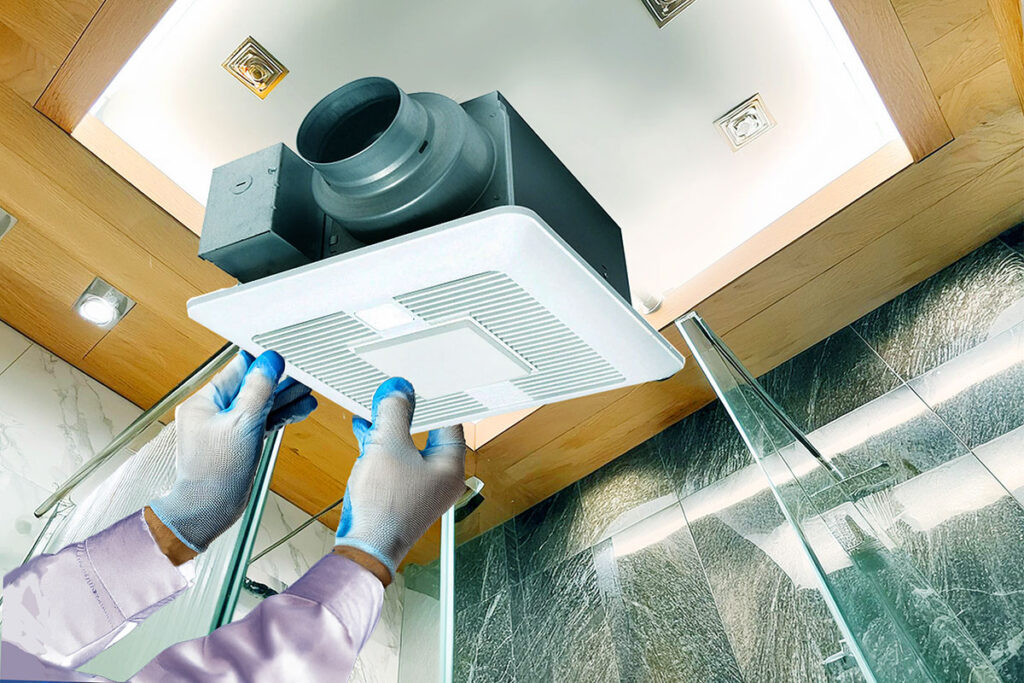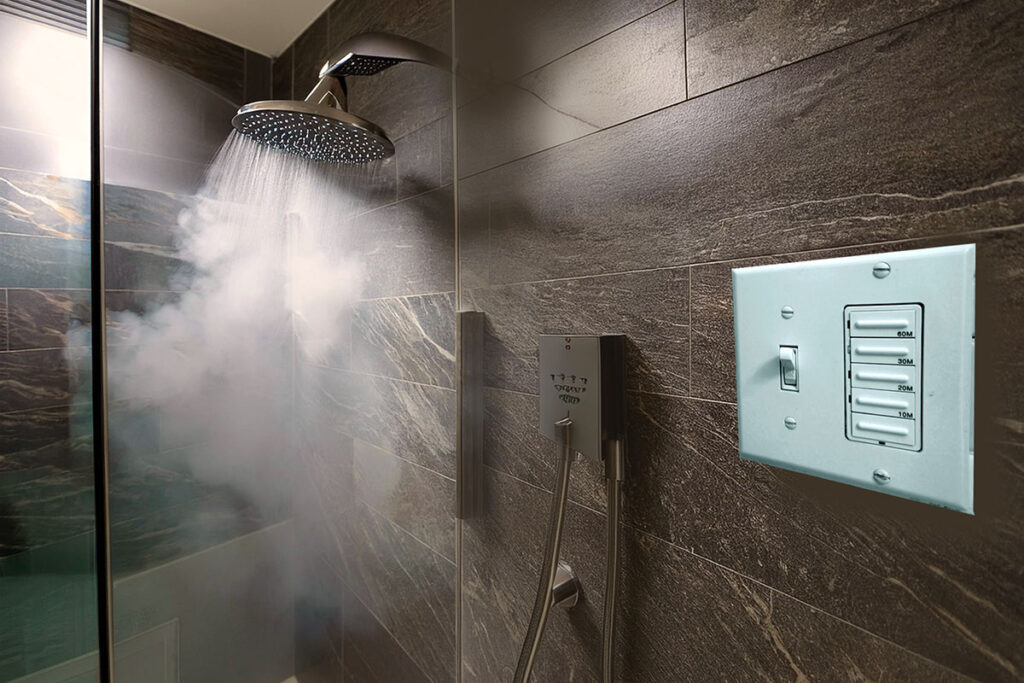This article explains the most important features of having well-functioning Bathroom Exhaust Fans installed in your home. It also includes answers by an expert electrician and installer to many common questions.
A bathroom exhaust fan is not just about odor removal. Here are some significant reasons they are necessary for every bathroom. One of the most essential fixtures in your bathrooms is the exhaust fan. They ensure the bathroom air is always fresh as a daisy, and exhaust fans help remove excess moisture and pollutants in the air.
Winter is an ideal time to install a new bathroom exhaust fan, as attic access is cooler for technicians than in summer. We hope this article will answer any questions you may have.

For this article, we asked the experts!
Captain Electric
These are reasons why you need properly installed bathroom exhaust fans,
along with some of the most asked questions and tips.
Mold can be invisible until it is too late.
Exhaust fans help reduce the risk of wall decay caused by too much moisture. A poorly installed bathroom exhaust fan can increase the chance of mold and mildew buildup behind your walls, around the shower, bathtub, and tiles. Many fans are exhausted in the attic and, if improperly installed, can result in costly renovations.
If you have some stubborn mildew that keeps returning even after scrubbing… you may have an exhaust fan problem.
An exhaust fan also draws air out of the bathroom through the door leading to other areas of your home. This increases the bath area’s ventilation so unpleasant airborne contaminants do not linger or migrate to other rooms. Regular use of a properly installed and vented bathroom exhaust fan will significantly improve the removal of excess moisture that can cause musty smells. Bathrooms with windows are good but not as efficient as an exhaust fan, and it is not always convenient to open a window in winter.
Prevent Mold
One of the most critical issues a bathroom exhaust fan helps prevent is mold! When it comes to mold, the saying, “An ounce of prevention is worth a pound of cure,” is absolutely true. Mold starts microscopically latching onto moist, dark areas. Mold spores float through indoor and outdoor air when a room is adequately ventilated. The spores keep moving along, which is the way it should be. Spores hanging around baseboards and walls can propagate in corners, cracks, and hidden places, developing into a serious problem before you know it. When you notice a musty smell, it can be just an early warning sign of something much worse.
When molds are left to grow undetected, health problems can occur from the presence of mycotoxins, which can act like irritants to people’s eyes, skin, nose, throat, and lungs, even in those who are not allergic to mold. Allergic responses to mycotoxins include hay fever-type symptoms, such as sneezing, runny nose, red eyes, and skin rashes. Those with asthma are often more sensitive to molds that can trigger a reaction.

If mold grows anywhere in your home, you must thoroughly clean it. In the worst instances, this involves the services of a professional. You must also find the source of the moisture problem and eliminate it, or the mold will return. Replacing or Installing an Exhaust Fan can save you money in the long run.
Choose a Bathroom Fan that suits your home and lifestyle.
Most bathrooms have variations of the same features: a sink or two, a toilet, a bathtub and/or shower, and possibly a bidet. Some also have a mini-sauna. The way each of us attends to the minutia of our personal grooming, such as washing, dressing, and arranging our hair, is unique to each of us. The kind of bathroom fan needs to be appropriate for your existing bath and lifestyle. Or, if you are planning a bathroom remodel, here are some things to consider about the type of fan you choose.
- Do you hurry to shower in the mornings before grabbing a bite of breakfast on the run and heading in to work? Are you always busy, and your bathroom usage is short?
- How many people will use a particular bathroom regularly?
- Do you have one full bath and a partial or more than one full bath?
- Do you or a family member enjoy taking time to luxuriate in a tubful of water on occasion?
- Do you enjoy taking candlelit baths and relaxing to music? If so, a fan that comes on automatically and turns the light on will impact your ability to enjoy the mood. You can have separate lighting from the exhaust fan and light connected to the fan for other times. You will also want to choose a low-noise fan.
- You no longer have to tolerate noisy fans that produce little airflow and possibly vent poorly.
- The newer switches allow you to time how long the exhaust fan and light will be on.
Is your home new or vintage?

Many newer homes today not only have separate toilet stalls in the master bedroom, but they also have separate showers, oversized whirlpool tubs, double sinks, dressing areas, storage for additional clean towels, etc. Bathroom styles have changed tremendously since the days of old, but with a bathroom renovation, you may find you can have either a vintage or a modern bathroom with all of the modern amenities you desire.

Here are some new ways to incorporate a bathroom exhaust fan into the look and feel of your bathroom.
- Recessed fans—Use a wall-mounted fan that is recessed into the wall, also known as an invisible fan.
- A fan that looks like a tile on the outside can be opened when needed.
- Paint the vent grille to match the color of the surrounding surfaces, or choose a metal finish that matches other metals in the bathroom.
Whether renovating an existing bathroom or installing a new exhaust fan, it is vital to consider bath usage.
The ages of your children can be a factor in bathroom design. Bathrooms for Toddlers need enough space and safety protocols to allow parental supervision and the fun of playtime in the tub. A proper exhaust fan can save your bathroom from too much moisture remaining in the room and ensure that the fan’s on/off functions are timed and safe.
How long does it take for towels to dry?
Multiple sources of damp items in a bathroom left to dry at various times can harbor bacteria, so if they are not dried within a reasonable time, you may have a humidity problem.
- Be sure to check all the aspects of an installation
- Applications for permits in your city. The Building Codes where your home is located can vary a great deal.
- Where to locate an exhaust fan,
- Venting processes,
- Electrical wiring,
- Be sure to hire licensed professionals. They carry insurance in case of accidents or damages during installation.
- Professionals have the proper tools and equipment for the job.
- Cutting a hole in the roof is often necessary for proper venting. Installing a bathroom exhaust fan, if not done correctly, can compromise the integrity of your roof.
- Did you know many house fires begin with improperly sized, vented, or wired bathroom exhaust fans?
- Check out the latest bathroom exhaust fan features that will fit your lifestyle, home, and interior decor.
Can a bathroom exhaust fan be installed without attic access?
Yes, there are some solutions to situations without attic access. A professional electrician will diagnose the condition and explain the steps needed during the initial inspection.
What is the cost?
Costs vary depending on the job. A professional electrician can assess the situation and give you a quote. An installation can involve many different problems that a professional will be able to handle.
How long does a typical bathroom exhaust fan work properly?
Typical bathroom exhaust fans last about ten years, but this can vary depending on the model, installation process, and usage.
How can I tell if I need a new bathroom exhaust fan?
- The air drawn through it is lessening.
- The noise of the fan has increased.
- The exhaust fan does not remove odors.
- Mildew is forming on the bathroom tiles.
- Mirrors fog up and stay that way for an inappropriate time.
- A light attached to the fan starts to blink.
- The bathroom stays moist and damp, and the towels do not dry.
- Inordinate sneezing and coughing occur in or near the bathroom, indicating a mold spore problem.
- The bathroom needs renovations to meet your current lifestyle and decor.
What are the Code requirements for venting a bathroom?
Although jurisdictions differ, the usual Code requirement for a bathroom vent fan is that it be vented to the exterior of the building and have at least 20 continuous airflows or 50 CFM intermittent. If there is no fan, the bathroom must have a window size of at least 3 sq. ft. or greater and be able to open in all weather.
Will there be visible wiring exposed during the installation?
Depending on the situation, new wiring may need to be installed through walls and ceilings to connect to the power source. Sometimes, your existing electrical system needs modifications to accommodate a new bathroom exhaust fan. This could include adding new outlets or switches or running new wiring through existing conduits. When it comes to any electrical process that is not a new build, things must be considered, such as how the wiring was done originally. Licensed professionals always make you aware of the steps involved during the initial discovery and inspection.
What happens when electrical work is not up to the current code?
There are no shortcuts to electricity. Once a problem has been identified, it is best to rectify it to ensure the safety of your home and family.
When is the best time to install a new bathroom exhaust fan?
The best time is during the fall, winter, and spring months. Temperatures in summer make it more difficult but not impossible.
Does a bathroom fan need to be on its own circuit?
When a built-in heater is present, the bathroom exhaust vent must have a dedicated 20-amp circuit. Heat lamps, wall heaters, and other built-in heating appliances may also require dedicated circuits.
How much does it cost to have a bathroom fan installed?
The installation cost depends on many factors in your home, such as the correct size for your bathroom, how it should be vented, the wiring needed, the type of model, and other requirements that best suit your lifestyle.
A licensed electrical professional considers all of your needs and ascertains the best procedures required for your home. Since these can vary considerably, installations are quoted individually. Always make sure you receive a quote in writing with the details listed.
At Captain Electric, we have inspected various homes to give a quote for an updated model, only to find that the current fan has been installed improperly or that a new installation has safety complications that the homeowner needs to be aware of. An experienced electrician will be able to give you an accurate quotation.
What happens if you don’t vent the bathroom?
If your bathroom isn’t correctly ventilated or without ventilation, the excess moisture generated will be absorbed by your walls, ceiling, and floors. This can result in mold growth and moisture damage over time. These conditions are expensive to correct and can amount to complete bathroom renovations.
Is it okay to vent a bathroom fan into the attic?
No! Bathroom exhaust fan vents that end in the attic often produce mold build-up. Also, water stain marks will appear on your ceilings. Slow damage to ceilings occurs that can lessen the integrity of the paint, wallpaper, tile, or other ceiling finishes. In some instances, drips can occur, leading you to believe you have a roof leak.
I have heard there are ductless bathroom fans. How do they work?
Ductless exhaust fans work similarly to kitchen stove exhaust fans, which recirculate the stove-top steam, trap grease and dirt, and neutralize odors through a charcoal filter instead of ductwork. They have a charcoal filtering system, allowing them to remove some moisture from the air and mitigate odors. The air is vented back into the kitchen. This is not always the best solution for bathroom exhaust since a great deal more moisture is generated in a bathroom.
How do I vent a bathroom fan without attic access?
When installing a new vent in a home without attic access, you must either create attic access by opening the bathroom ceiling or cut an opening and place the duct vent through an exterior wall.
Does a bathroom fan use a lot of electricity?
A large-capacity fan model can use as much as 1,500 watts, while the average bathroom fan with a basic light fixture uses about 36 watts. A variable timer installed with the fan can provide electrical savings. This lets you set the preferred time without worrying about shutting the fan off.
Are bathroom exhaust fans worth it?
Bathroom exhaust fans are an essential part of a home’s ventilation system. They eliminate odors, improve indoor air quality, and remove moisture and humidity that can lead to structural damage, mildew, and mold growth.
Where should you install a bathroom exhaust fan?
The fan exhaust must vent directly to the exterior of the home. The best place is in the center of the bathroom. However, you also have to consider where the shower and bathtub are located. If placed in the wrong area, it can pull the moisture from the shower across the room rather than venting it straight out and away. When a licensed professional electrician performs an inspection before doing their quote, they will ascertain the best place in your particular bathroom. In every instance, communication with the homeowner and explanations of why a particular procedure is needed allows for a win-win understanding of the situation.
It is important not to put the vent termination in a roof overhang or soffit. If the vent is placed on a wall near or under a roof overhang, the moist air that gushes out through the fan can be sucked right up into the open soffit vents and drawn into your attic. If this is the case with any of your old bathroom exhaust fans, immediately call a professional in your area for an assessment and quote.
How do you vent a bathroom in the middle of a house?
A central exhaust fan can be installed if your bathroom has only internal walls. This will channel air outdoors through pipes or ventilation shafts. In such an instance, running an insulated pipe through is a good idea to avoid moisture seepage. This can be a relatively practical and cost-effective solution for windowless bathrooms.
How far can you run a vent for a bathroom fan?
The insulation keeps humidity from condensing inside the duct and helps prevent water pooling, which can damage ducts at the core. Generally, an insulated flexible duct and air connector can carry a fan exhaust for up to 25 feet. Some experts say up to a hundred feet if managed properly. However, the Codes in your area must be adhered to.
Should bathroom fans be wired to the light switch?
Condensation from hot water produces mold and can shorten the life of light fixtures and bulbs, but the water will not condense if the fan takes the vapor out before it has a chance. Connecting your bathroom fan and light on the same switch is an effective way to avoid both.
There are times when you would like to have a candlelit bath. In this case, you can also install a separate light. Candles are fun, but you should have other ambient light sources to avoid any mishaps in the dark.
Can a bathroom fan and light be on the same circuit?
Many bathroom fans include lights with the intention of being wired to one switch on the same circuit. They can also be wired separately to different switches.
What happens if you leave the bathroom fan on too long?
Older bathroom fans can become overheated, especially when clogged by lint and dust. We have all witnessed a bathroom exhaust fan that has been left on unintentionally, especially if it has a quiet motor. This can be dangerous since the heat can ignite the lint and cause a fire.
One solution is to have an automatic run-time or automatic shut-off. So many new features are available that can be more convenient and safe.
How long can a bathroom fan be left on?
A bathroom fan can safely run for about 30 minutes. A small fan can take half an hour to clear the air after a shower or bath, so you may want to start the fan right before you start.
Should I be concerned about running the bathroom fan when winter air is so dry?
If the humidity gets high enough to cause condensation on mirrors and other bathroom surfaces and remains for more than fifteen minutes, it produces too much moisture. This can result in mold growth.
Do bathroom fans get rid of summer humidity?
Bathroom exhaust fans and vent fans for your stove can be vital in keeping a low humidity level in your house. These products are designed to remove the excess humidity created by showering, boiling water, and other activities that will create extra moisture in the air.
How do you ventilate a bathroom after a shower?
Let the bathroom vent exhaust fan run throughout your bath or shower, and, just as importantly, leave it on for at least 15 minutes after you’re finished to fully air out the space. Turning the fan off right after your shower or bath doesn’t give the device enough time to vent all the shower steam.
I don’t like the sound of my noisy bathroom fan. What can I do about that?
Newer models can be whisper quiet. Be sure to select a fan style that suits your preferences. Remember, communication before installation is better than after the fact.
What is the difference between a bathroom exhaust fan and a ventilation fan?
An exhaust fan removes pollutants, odors, and excess moisture from a home’s indoor air, while a ventilation fan brings clean air into an enclosed space from outside.
Are bathroom exhaust fans a fire hazard?
A bathroom exhaust fan is an electrical appliance. It must be maintained properly and regularly examined for dust or lint build-up. Fans that are poorly vented, wrongly sized for the room, or not powerful enough to do their job can pose a fire risk. Exhaust fans need to be replaced about every ten years.
What causes bathroom fans to catch fire?
The most common causes of bathroom exhaust fan fires are:
- Faulty wiring.
- Running the fan for extended periods causes the motor to overheat.
- Failing to maintain and clean the fan.
- Failing to replace a fan when it is too old.
- An improperly installed fan.
- An incorrectly vented fan.
How do I stop my bathroom fan from Backdrafting cold air?
Most newer fans are equipped with a backdraft flap. If it has become lodged open, you can easily move the flapper with your hand back into place so that the cold air is blocked from entering. However, on some models, cold drafts can still find their way in, especially when winter winds are high. You can get an exhaust fan draft blocker if this is the case.
Impossible Bathroom Cleanups!
Before mold forms and causes you to need to hire a biohazard cleanup service, ensure your bathroom exhaust fans are up to date and functioning.
Special thanks to Captain Electric for providing answers to questions regarding the installation of Bathroom Exhaust Fans.



